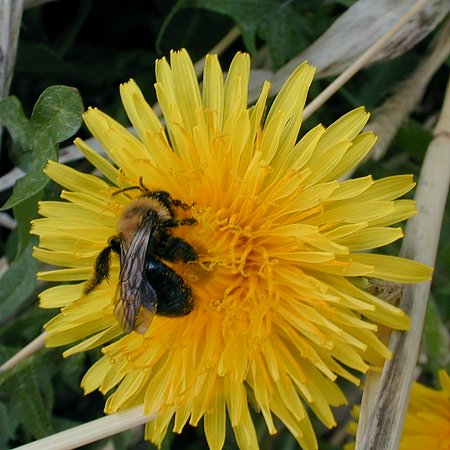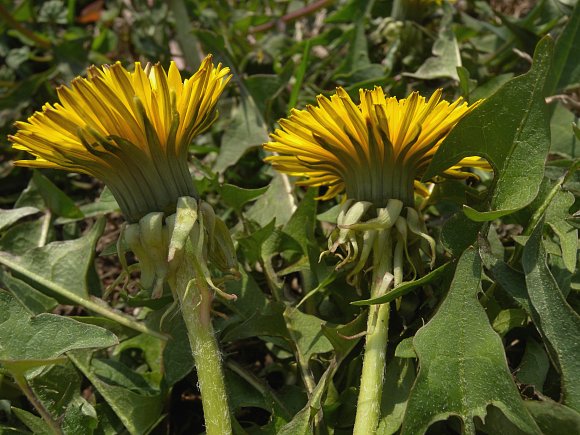Description: This herbaceous perennial plant consists of a rosette of basal leaves and occasional flowering stalks. The basal leaves are individually up to 10" long and 2½" across. The typical basal leaf is broader toward its outer tip than at the base (oblanceolate) in outline, although it is more or less lobed (pinnatifid) along its length. These lobes are triangular. The margins are slightly wavy and irregular, and sometimes coarsely dentate. There is a prominent central vein along the length of each leaf that is hollow and contains milky juice. This vein is usually green, but it sometimes becomes reddish green toward the base. The leaves are usually hairless, although young leaves are sometimes slightly pubescent. From the center of the rosette, one or more flowering stalks are produced that are up to 18" tall, although usually 12" or less. Each slender stalk is round and hollow, and contains milky juice. It is usually light green, sometimes becoming light reddish green toward the base. There may be some appressed cobwebby hairs along its length. At the apex of each flowering stalk, there is a single yellow flowerhead about 1-2" across.

This flowerhead
has about 150-200 yellow ray florets and no disk florets; the ray
florets spread outward from the center. At the base of the flowerhead,
there are inner and outer bracts that are green. The inner bracts are
linear or linear-lanceolate and appressed together to form a
cylindrical tube around the ovaries of the flowerhead. The outer bracts
are linear-lanceolate and sharply curve downward. The flowerheads are
produced sporadically from early spring to late fall; they are most
like to occur during the late spring or early summer. There is a
pleasant floral scent that is somewhat musty and pollen-laden. Each ray
floret produces a single slender achene that is light brown, light
gray, or slightly olive green. An achene has 5-10 longitudinal ribs
with tiny teeth toward its apex. A long slender beak connects the
achene with a tuft of white hairs. This beak is 2-3 times as long as
the achene. Collectively, these tufts of hair produce a spheroid mass
that is white and feathery in appearance. The achenes are dispersed by
the wind. The root system consists of a stout taproot that is up to 3'
long (if not more). This taproot contains milky juice and is somewhat
fleshy. This plant spreads by reseeding itself. It can form large
colonies.
Cultivation:
The preference is full sunlight, mesic conditions, and a soil that
consists of loam or clay-loam. Partial sunlight is also tolerated. This
plant can be very aggressive, and it can regenerate from small pieces
of
the taproot.

Range &
Habitat:
Dandelion is a very common plant that occurs in every county of
Illinois (see Distribution
Map). It was introduced to North America from Europe.
Habitats include lawns, gardens, degraded meadows, vacant lots, and
sunny areas along roads and railroads. Dandelion has little capacity to
invade high quality natural habitats, always preferring open areas that
are disturbed and degraded by human-related activities.
Faunal Associations:
The nectar and pollen of the flowerheads primarily attract long-tongued
bees, short-tongued bees, and bee flies. Among the bees, are such
visitors as bumblebees, honeybees, mason bees, Halictid bees, and
Andrenid bees. Less often, butterflies and skippers suck nectar from
the flowerheads, while occasional beetles feed on the pollen. The
foliage, seeds, roots, and other parts of Dandelion (Taraxacum
officinale) are eaten by many kinds of
insects, including adult ground beetles (seeds), aphids (primarily
roots), mealybugs (primarily foliage), the larvae of many moths
(primarily foliage), and grasshoppers (primarily foliage). The Insect
Table provides a more complete list of these insect feeders. Among
vertebrate animals, such songbirds as the Indigo Bunting, Chipping
Sparrow, and American Goldfinch eat the seeds, while such upland
gamebirds as the Ruffed Grouse, Hungarian Partridge, and Greater
Prairie Chicken eat the leaves and/or seeds (Martin et al., 1951/1961;
DeVore et al., 2004). Because of its white latex, the foliage of
Dandelion is somewhat bitter. Nonetheless, it is consumed by the
Prairie Vole, Meadow Vole, and Woodland Vole (which may also eat the
roots); the Groundhog, White-tailed Deer, and domesticated livestock
also eat the foliage occasionally (Cole & Batzli, 1979; Lindroth
& Batzli, 1984; Martin et al., 1951/1961). The American Black Bear
eats both the foliage and flowerheads of Dandelion, while the
Thirteen-lined Ground Squirrel eats its flowerheads and seeds
(Whitaker, 1972; Romain et al., 2013; Mosnier et al., 2008). Somewhat
surprisingly, both the Wood Turtle and Ornate Box Turtle have been
observed to feed on the leaves of this plant as well (Lagler, 1943;
Ernst et al., 1994).
Photographic Location:
At the apartment complex of the webmaster in Urbana, Illinois.

Comments: The young leaves of Dandelion are sometimes used fresh in salads, or boiled as a potherb. When the flowerheads develop, the foliage becomes increasingly bitter and tough. The leaves are high in vitamins and minerals. Sometimes the flowerheads are used to make dandelion wine. Most people regard Dandelion as a pernicious weed (with some justification), even though the flowers are quite attractive. Because it can bloom very early or very late in the year, the nectar or pollen of the flowerheads are a valuable source of food to some pollinating insects, especially bees. There are many members of the Aster family that produce a rosette of leaves with stalks of flowerheads that consist entirely of yellow ray florets. As a result, people sometimes confuse other species in this group with Dandelion. Dandelion has the following characteristics that may be useful in making a correct identification: 1) the outer green bracts curve sharply downward from the flowerheads, 2) only a single flowerhead is produced from a hollow flowering stalk, and 3) the outermost lobe of each leaf is the largest. There is also another dandelion species, Taraxacum erythrospermum (Red-Seeded Dandelion) that sometimes occurs in Illinois. This species has achenes that are reddish brown and its leaves are more deeply pinnatifid than the typical Dandelion. Also, the slender beak connecting the achene with its tuft of hair is shorter (up to twice the length of the achene) in this species than the beak of the typical Dandelion (2-3 times as long as the achene).